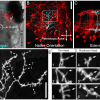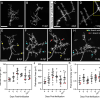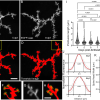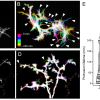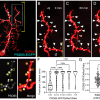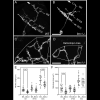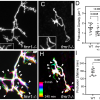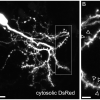Description
Dendritic spines are the principal site of excitatory synapse formation in the human brain. Several neurodevelopmental disorders cause spines to develop abnormally, resulting in altered spine number and morphology. While spine development has been thoroughly characterized in the mammalian brain, spines are not unique to mammals. We have developed a genetic system in zebrafish to enable high resolution in vivo imaging of spine dynamics during larval development. Although spiny neurons are rare in the larval zebrafish, pyramidal neurons (PyrNs) of the zebrafish tectum form an apical dendrite containing a dense array of dendritic spines. To characterize dendritic spine development, we performed mosaic genetic labeling of individual PyrNs labeled by an id2b:gal4 transgene. Our findings identify a developmental period when PyrN dendrite growth is concurrent with spine formation. Throughout this period, motile, transient filopodia gradually transform into stable spines containing postsynaptic specializations. The utility of this system to study neurodevelopmental disorders was validated by examining spine development in fmr1 mutant zebrafish, a model of Fragile X syndrome. PyrNs in fmr1 mutants exhibit pronounced defects in dendrite growth and spine stabilization. Together, these findings establish a genetic labeling system to study dendritic spine development in larval zebrafish. In the future, this system could be combined with high throughput screening approaches to identify genes and drug targets that regulate spine formation.
Cite this work
Researchers should cite this work as follows:
- DeMarco, E. C.; Stoner, G. R.; Robles, E. (2022). A genetic labeling system to study dendritic spine development in zebrafish. Purdue University Research Repository. doi:10.4231/0BQQ-DV64
